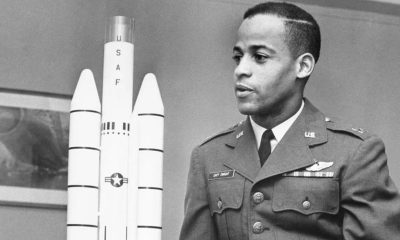Black History
Yasuke, the Black Samurai
Not much has been recorded of Yasuke’s life. There are no verifiable records after 1582, and his birth country is unknown. What researchers do know is that Yasuke was a Black samurai who “served under Oda Nobunaga, one of the most important feudal lords in Japanese history and a unifier of the country,” wrote TIME journalist Kat Moon.

By Tamara Shiloh
The year was 1579 when Yasuke, an African man standing more than 6 feet tall and possessing the strength of 10 men arrived in Japan. With him was Alessandro Valignano, an Italian Jesuit. The pair came by way of India, according to Thomas Lockley, a coauthor of “African Samurai: The True Story of Yasuke, a Legendary Black Warrior in Feudal Japan.” Yasuke was most likely in service to Valignano as a bodyguard.
“As a priest, he wasn’t allowed to have any soldiers or guards,” Lockley said about Valignano during an interview with TIME. “Euphemistically, they had valets—manservants if you’d like—who were also versed in weapons.”
Not much has been recorded of Yasuke’s life. There are no verifiable records after 1582, and his birth country is unknown. What researchers do know is that Yasuke was a Black samurai who “served under Oda Nobunaga, one of the most important feudal lords in Japanese history and a unifier of the country,” wrote TIME journalist Kat Moon.
Lockley speculates that “given the circumstances of how the African man arrived at his employment with Valignano, it’s possible that Yasuke was enslaved as a child and taken from Africa to India,” and earned his freedom prior to meeting Valignano. Yasuke wasn’t “a slave in any sense of the word, I think he was a free actor,” Lockley said.
Much of what has been recorded about Yasuke was done so in notes found in Nobunaga’s records, the writings suggesting that Yasuke was viewed as a close friend. In fact, Nobunaga later took Yasuke under his wing.
Lockley added that Yasuke seemed to be “a confidant,” and that “Nobunaga is recorded as talking often with him. He was also a “weapon bearer” and likely served as a bodyguard.
During that time, few Japanese people had encountered an African man. Many who saw Yasuke considered him the embodiment of the black-skinned Buddha. Nobunaga was no exception, making Yasuke a samurai in his court.
In 2021, Netflix released its original animated series, “Yasuke.” Set in 16th century Japan, the storyline trails a lonely boatman known as the Black Samurai on his journey to protect a young girl with magical powers. Actor LaKeith Stanfield is the voice of the boatman, a role originally designated for the the late Chadwick Boseman.
It is likely that in later years foreigners from places including Africa, China, and Korea served in warrior positions in Japan. Yasuke though, “is supposedly the first recorded,” according to Lockley. “There are several records of Black Africans serving more minor lords, and we don’t know so much about them because the lords they were serving were more minor.”
Yasuke served Nobunaga faithfully until his death in 1582 in what the Japanese refer to as the Honnō-ji Incident.
Read more about the famous African samurai while learning African and Japanese history in “African Samurai: The True Story of Yasuke, a Legendary Black Warrior in Feudal Japan,” by Geoffrey Girard and Thomas Lockley.
Source: https://time.com/6039381/yasuke-black-samurai-true-story/
https://en.wikipedia.org/wiki/Yasuke
https://foreignpolicy.com/2021/05/02/the-real-yasuke-is-far-more-interesting-than-his-netflix-show/
Activism
Oakland Post: Week of April 24 – 30, 2024
The printed Weekly Edition of the Oakland Post: Week of April 24 – 30, 2024

To enlarge your view of this issue, use the slider, magnifying glass icon or full page icon in the lower right corner of the browser window. ![]()
Activism
Oakland Post: Week of April 17 – 23, 2024
The printed Weekly Edition of the Oakland Post: Week of April 17 – 23, 2024

To enlarge your view of this issue, use the slider, magnifying glass icon or full page icon in the lower right corner of the browser window. ![]()
Black History
Matthew Henson: Explorer Extraordinaire
Matthew Henson, a trailblazing explorer who overcame countless obstacles to leave an incredible mark on history. Born on August 8, 1866, in Charles County, Maryland, his journey is a testament to the power of determination and the spirit of adventure.

By Tamara Shiloh
Matthew Henson, a trailblazing explorer who overcame countless obstacles to leave an incredible mark on history. Born on August 8, 1866, in Charles County, Maryland, his journey is a testament to the power of determination and the spirit of adventure.
Henson’s life began amidst the backdrop of post-Civil War America, where opportunities for African Americans were scarce. From a young age, he possessed an insatiable curiosity about the world beyond his small town. At the age of 12, he embarked on a journey that would change the course of his life forever when he joined a merchant ship as a cabin boy.
His most famous expedition was his journey to the Arctic with renowned explorer Robert E. Peary. In 1887, Henson joined Peary’s crew as a seaman and quickly proved himself to be invaluable with his skills as a navigator and craftsman. Over the course of several expeditions, Matthew endured extreme cold, treacherous terrain, and grueling conditions as he and Peary sought to reach the elusive North Pole.
In 1908–09, Peary set out on his eighth attempt to reach the North Pole. It was a big expedition, with Peary planning to leave supplies along the way. When he and Henson boarded their ship, the Roosevelt, leaving Greenland on August 18, 1909, they were joined by a large group. This included 22 Inuit men, 17 Inuit women, 10 children, 246 dogs, 70 tons of whale meat, blubber from 50 walruses, hunting gear, and tons of coal.
In February, Henson and Peary left their anchored ship at Ellesmere Island’s Cape Sheridan, along with the Inuit men and 130 dogs. They worked together to set up a trail and supplies along the way to the Pole.
Peary picked Henson and four Inuit people to join him in the final push to the Pole. However, before they reached their destination, Peary couldn’t walk anymore and had to ride in a dog sled. He sent Henson ahead to scout the way. In a later interview with a newspaper, Henson recalled being in the lead and realizing they had gone too far. The group turned back, and Henson noticed his footprints helped guide them to their destination. At that location, Henson planted the American flag.
Henson’s legacy extends far beyond his expeditions to the Arctic. He shattered racial barriers in the world of exploration and inspired countless individuals, regardless of race, to dream big and pursue their passions. In 1937, he was finally recognized for his achievements when he was inducted into The Explorers Club, an organization dedicated to promoting scientific exploration and field research.
Matthew Henson died in the Bronx, New York, on March 9, 1955, at the age of 88.
-

 Activism4 weeks ago
Activism4 weeks agoOakland Post: Week of March 27 – April 2, 2024
-

 #NNPA BlackPress4 weeks ago
#NNPA BlackPress4 weeks agoBeloved Actor and Activist Louis Cameron Gossett Jr. Dies at 87
-

 Community1 week ago
Community1 week agoFinancial Assistance Bill for Descendants of Enslaved Persons to Help Them Purchase, Own, or Maintain a Home
-

 Activism3 weeks ago
Activism3 weeks agoOakland Post: Week of April 3 – 6, 2024
-

 Business2 weeks ago
Business2 weeks agoV.P. Kamala Harris: Americans With Criminal Records Will Soon Be Eligible for SBA Loans
-

 Activism2 weeks ago
Activism2 weeks agoOakland Post: Week of April 10 – 16, 2024
-

 Community2 weeks ago
Community2 weeks agoAG Bonta Says Oakland School Leaders Should Comply with State Laws to Avoid ‘Disparate Harm’ When Closing or Merging Schools
-

 Community7 days ago
Community7 days agoOakland WNBA Player to be Inducted Into Hall of Fame

























































